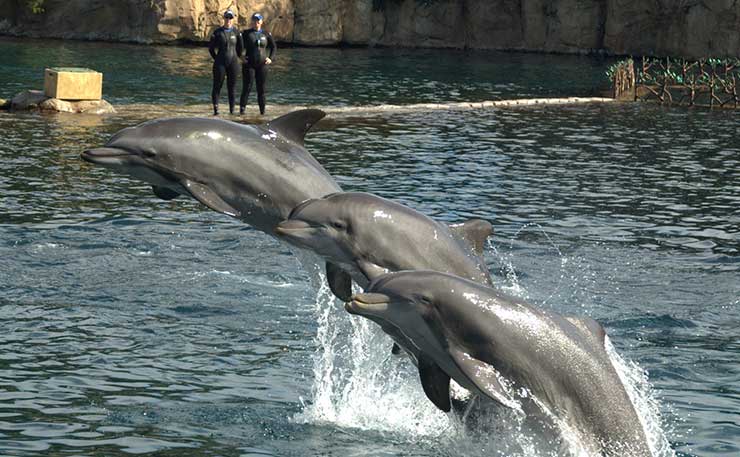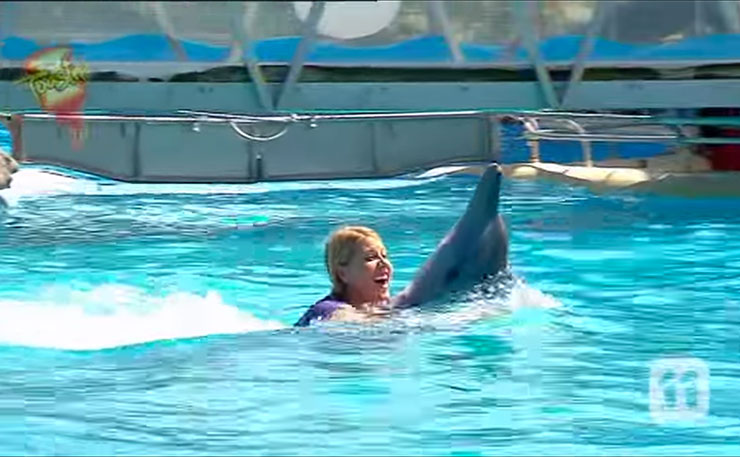Australia’s two remaining marine parks make money from the suffering of innocent animals. Jordan Sosnowski from Australia For Dolphins explains.
Recently, more than 20 demonstrators protested during a dolphin show at Sea World, arguing the animals should not be held in pools for entertainment.
It’s easy to write off the activists as “crazy vegetarians” and green-haired killjoys. Certainly some of the marine park audience felt this way and angrily booed the peaceful protestors off stage.
But on social media, thousands are rallying behind the campaigners and their home-made “captivity is cruelty” signs. Just as circuses are in decline, so too are people starting to realise there’s something not quite right about keeping dolphins in chlorinated pools performing tricks for scraps of fish.
Even former NSW Premier Bob Carr agrees dolphin captivity should be abolished. The simple reason? It’s plain cruel.

When dolphins are not performing in circus shows, they have no alternative but to swim endless circles in their tanks or lie listlessly for hours on end.
Think of having a nice, long, relaxing bath. Except by long I mean about 47 years. It starts to become understandable why these intelligent animals get bored with the monotony of life in a small, barren pool.
The pool water at marine parks is often chlorinated – largely to accommodate paying guests who participate in “swim-with” programs. So while people are shielded from pee and other nasties, the chlorine eats away at dolphins’ sensitive skin and irritates their eyes.
Life expectancy for wild Bottlenose dolphins is approximately 40-50 years. But in captivity many die young. Just recently, a dolphin calf died in New South Wales after swallowing metal and leaf litter in his pool. More than 50 dolphin deaths have occurred at Sea World, Gold Coast. Causes of death include multiple fractures, massive head trauma, and chronic abscess.
Unsurprisingly, numerous studies, including an Australian Senate Report, have found that dolphins suffer stress and anxiety in captivity. The reason why this practice continues in Australia (when we are fortunate enough to see dolphins in the wild), is all about perception.
Sadly for dolphins, they never outwardly look as if they are unhappy. As evolution would have it, their jaws evolved into an upward line, suited to effectively catching fish. However this Darwinian “smile” is deceptive, as it masks their suffering and makes people think they are happy in captivity when the science demonstrates they’re not.
Marine parks also work hard to convince visitors that captivity is justified because of all the wonderful rescue and conservation work being done. The documentary Blackfish provides ample evidence of US SeaWorld’s trainers blatantly misinforming visitors in relation to animals’ life expectancy. Sea World Australia spends a tiny percentage – less than one percent – of its revenue on rescue and rehabilitation.
The simple truth is that marine parks breed dolphins purely for entertainment.
One former marine mammal trainer who spoke to charity Australia for Dolphins under the promise of anonymity, worked at both Australia’s remaining marine parks. The source explained that part of his job was “training dolphins to give semen and the females to accept things around their areas”. This was apparently “a skill” brought in by another trainer from Portugal and the semen was collected for use in the future.
If people knew the truth that the majority of dolphins in marine parks are not rescued from dire situations, but instead deliberately bred for profit, they would perhaps think twice about buying a ticket. Similarly, if it was common knowledge that dolphins simply cannot thrive in captivity – parents would not take their children to marine parks.
People may say that there is no alternative for captive dolphins as they can’t be safely released. But due to the growing movement against cetacean captivity, the National Aquarium in Baltimore is building a sea sanctuary for their captive dolphins.
The recent protest at Sea World is helping to build momentum for a sanctuary to be established here in Australia. But abolishing dolphin captivity and ending the captive breeding of dolphins will only happen with a push from the public.
This begins by voting with our wallets and thinking twice before buying into dolphin cruelty.
Donate To New Matilda
New Matilda is a small, independent media outlet. We survive through reader contributions, and never losing a lawsuit. If you got something from this article, giving something back helps us to continue speaking truth to power. Every little bit counts.





